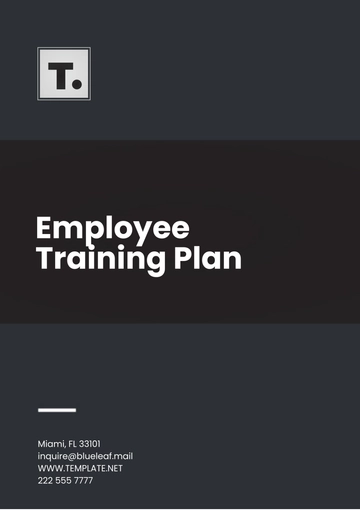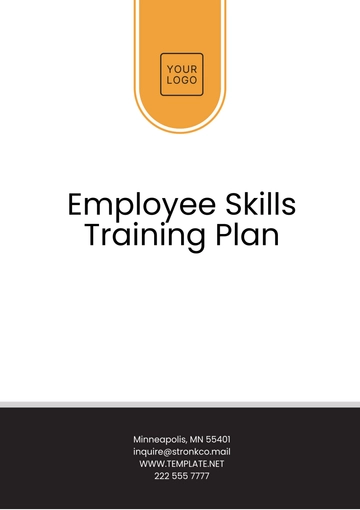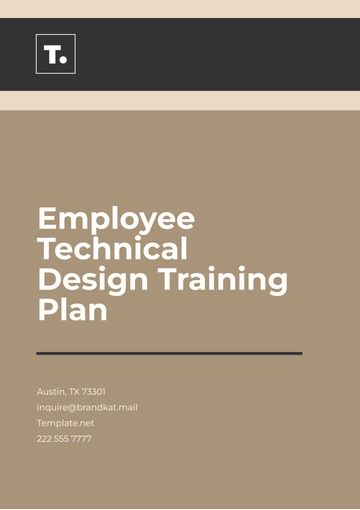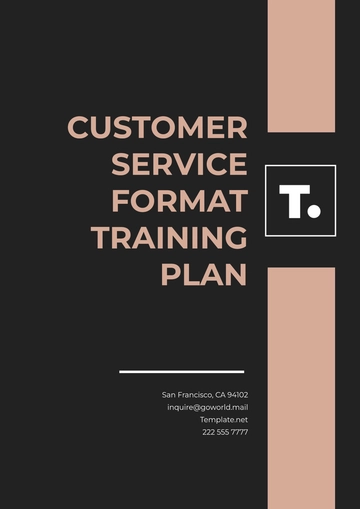Free Sample Monthly Employee Training Plan

Prepared by: [Your Name]
Date: November 8, 2050
I. Introduction
This Monthly Employee Training Plan is designed to enhance the skills, knowledge, and competencies of employees, ensuring they stay aligned with industry best practices and organizational goals. By continuously developing our workforce, we aim to foster a culture of growth, drive productivity, and ensure compliance with evolving standards.
II. Training Objectives
The primary objectives of this training plan are:
Enhance Employee Skillsets: Equip employees with the necessary tools and knowledge to perform their roles effectively and adapt to technological advancements.
Ensure Compliance with Industry Standards: Keep employees informed of regulatory changes, industry standards, and best practices.
Foster a Culture of Continuous Learning: Encourage self-improvement and growth through regular learning opportunities, empowering employees to take ownership of their professional development.
Improve Organizational Performance: Ensure that every employee's development directly contributes to the overall success of the organization, enhancing both individual and collective performance.
III. Training Schedule
The training sessions are designed to cater to diverse learning styles and foster skill development. Training activities are organized on a monthly basis to ensure consistent and manageable learning opportunities.
1. Monthly Training Calendar
Week | Training Topic | Duration | Mode | Expected Outcomes |
|---|---|---|---|---|
Week 1 | Introduction to Company Policies | 2 hours | Online | Familiarity with company policies, ethics, and regulations. |
Week 2 | Technical Skills Development | 3 hours | In-person | Improved technical skills relevant to specific roles. |
Week 3 | Communication and Teamwork | 2 hours | Online | Enhanced communication skills and collaborative teamwork. |
Week 4 | Project Management Essentials | 3 hours | In-person | Understanding project management tools, techniques, and workflows. |
2. Assessment and Feedback
At the end of each training session, employees will participate in a brief assessment to evaluate knowledge retention and the effectiveness of the training. Feedback will be collected through surveys, one-on-one interviews, and focus groups to assess the relevance and quality of the training.
Assessment Types: Quizzes, practical exercises, case studies, and peer evaluations.
Feedback Mechanisms: Anonymous surveys, follow-up interviews, and group discussions to understand the challenges faced by employees and improve the next cycle of training.
IV. Training Resources
To support the training initiatives, the following resources will be made available to employees:
Access to E-learning Platforms: Online courses and modules that employees can access at their convenience to support ongoing learning.
Industry-Specific Journals and Articles: Subscription to leading publications and research papers to stay current with industry trends and innovations.
Video Tutorials and Webinars: A library of instructional videos and live sessions with industry experts to reinforce learning and introduce new concepts.
Training Manual and Guides: Detailed materials that employees can refer to during and after training to apply learned skills.
V. Employee Development Tracking
To ensure ongoing growth, employees' progress will be tracked using a development dashboard. This will help in identifying:
Skill Gaps: Areas where additional training may be needed.
Training Progress: How employees are progressing across various modules.
Certifications and Achievements: Documenting completed courses, certifications earned, and special recognitions.
VI. Mentorship and Support
In addition to structured training sessions, employees will have the opportunity to be paired with a mentor for personalized guidance and support. The mentorship program will focus on:
Career Development: Mentors will help employees set career goals and provide advice on navigating career paths within the organization.
Problem-Solving: Mentors will assist with any work-related challenges or skill gaps, offering personalized advice and solutions.
Leadership Training: High-performing employees may be considered for leadership roles and will undergo special mentorship to prepare them for future leadership opportunities.
VII. Performance Metrics and Evaluation
The success of the training plan will be evaluated based on the following key performance indicators (KPIs):
Employee Engagement: Measured by participation rates in training programs, completion rates, and the level of enthusiasm during sessions.
Knowledge Retention: Through post-training assessments and quizzes.
Impact on Job Performance: The correlation between training completion and job performance, as assessed by managers.
Return on Investment (ROI): The measurable impact of training on productivity, efficiency, and quality of work.
VIII. Conclusion
This monthly training plan is not just a commitment to enhancing the skills of individual employees but also a strategic initiative to support the organization's long-term goals. By adhering to this plan, we aim to create a dynamic and skilled workforce that drives organizational success, fosters a positive work culture, and adapts to the industry's ever-evolving needs. Together, we can ensure that our workforce remains competent, motivated, and aligned with our vision for the future.
- 100% Customizable, free editor
- Access 1 Million+ Templates, photo’s & graphics
- Download or share as a template
- Click and replace photos, graphics, text, backgrounds
- Resize, crop, AI write & more
- Access advanced editor
Streamline employee development with the Sample Monthly Employee Training Plan Template from Template.net. This fully editable and customizable template simplifies training scheduling and tracking. Editable in our Ai Editor Tool, it enables tailored adjustments to align with unique business needs, ensuring an efficient, organized approach to workforce training and skill enhancement, month after month.
You may also like
- Finance Plan
- Construction Plan
- Sales Plan
- Development Plan
- Career Plan
- Budget Plan
- HR Plan
- Education Plan
- Transition Plan
- Work Plan
- Training Plan
- Communication Plan
- Operation Plan
- Health And Safety Plan
- Strategy Plan
- Professional Development Plan
- Advertising Plan
- Risk Management Plan
- Restaurant Plan
- School Plan
- Nursing Home Patient Care Plan
- Nursing Care Plan
- Plan Event
- Startup Plan
- Social Media Plan
- Staffing Plan
- Annual Plan
- Content Plan
- Payment Plan
- Implementation Plan
- Hotel Plan
- Workout Plan
- Accounting Plan
- Campaign Plan
- Essay Plan
- 30 60 90 Day Plan
- Research Plan
- Recruitment Plan
- 90 Day Plan
- Quarterly Plan
- Emergency Plan
- 5 Year Plan
- Gym Plan
- Personal Plan
- IT and Software Plan
- Treatment Plan
- Real Estate Plan
- Law Firm Plan
- Healthcare Plan
- Improvement Plan
- Media Plan
- 5 Year Business Plan
- Learning Plan
- Marketing Campaign Plan
- Travel Agency Plan
- Cleaning Services Plan
- Interior Design Plan
- Performance Plan
- PR Plan
- Birth Plan
- Life Plan
- SEO Plan
- Disaster Recovery Plan
- Continuity Plan
- Launch Plan
- Legal Plan
- Behavior Plan
- Performance Improvement Plan
- Salon Plan
- Security Plan
- Security Management Plan
- Employee Development Plan
- Quality Plan
- Service Improvement Plan
- Growth Plan
- Incident Response Plan
- Basketball Plan
- Emergency Action Plan
- Product Launch Plan
- Spa Plan
- Employee Training Plan
- Data Analysis Plan
- Employee Action Plan
- Territory Plan
- Audit Plan
- Classroom Plan
- Activity Plan
- Parenting Plan
- Care Plan
- Project Execution Plan
- Exercise Plan
- Internship Plan
- Software Development Plan
- Continuous Improvement Plan
- Leave Plan
- 90 Day Sales Plan
- Advertising Agency Plan
- Employee Transition Plan
- Smart Action Plan
- Workplace Safety Plan
- Behavior Change Plan
- Contingency Plan
- Continuity of Operations Plan
- Health Plan
- Quality Control Plan
- Self Plan
- Sports Development Plan
- Change Management Plan
- Ecommerce Plan
- Personal Financial Plan
- Process Improvement Plan
- 30-60-90 Day Sales Plan
- Crisis Management Plan
- Engagement Plan
- Execution Plan
- Pandemic Plan
- Quality Assurance Plan
- Service Continuity Plan
- Agile Project Plan
- Fundraising Plan
- Job Transition Plan
- Asset Maintenance Plan
- Maintenance Plan
- Software Test Plan
- Staff Training and Development Plan
- 3 Year Plan
- Brand Activation Plan
- Release Plan
- Resource Plan
- Risk Mitigation Plan
- Teacher Plan
- 30 60 90 Day Plan for New Manager
- Food Safety Plan
- Food Truck Plan
- Hiring Plan
- Quality Management Plan
- Wellness Plan
- Behavior Intervention Plan
- Bonus Plan
- Investment Plan
- Maternity Leave Plan
- Pandemic Response Plan
- Succession Planning
- Coaching Plan
- Configuration Management Plan
- Remote Work Plan
- Self Care Plan
- Teaching Plan
- 100-Day Plan
- HACCP Plan
- Student Plan
- Sustainability Plan
- 30 60 90 Day Plan for Interview
- Access Plan
- Site Specific Safety Plan
























